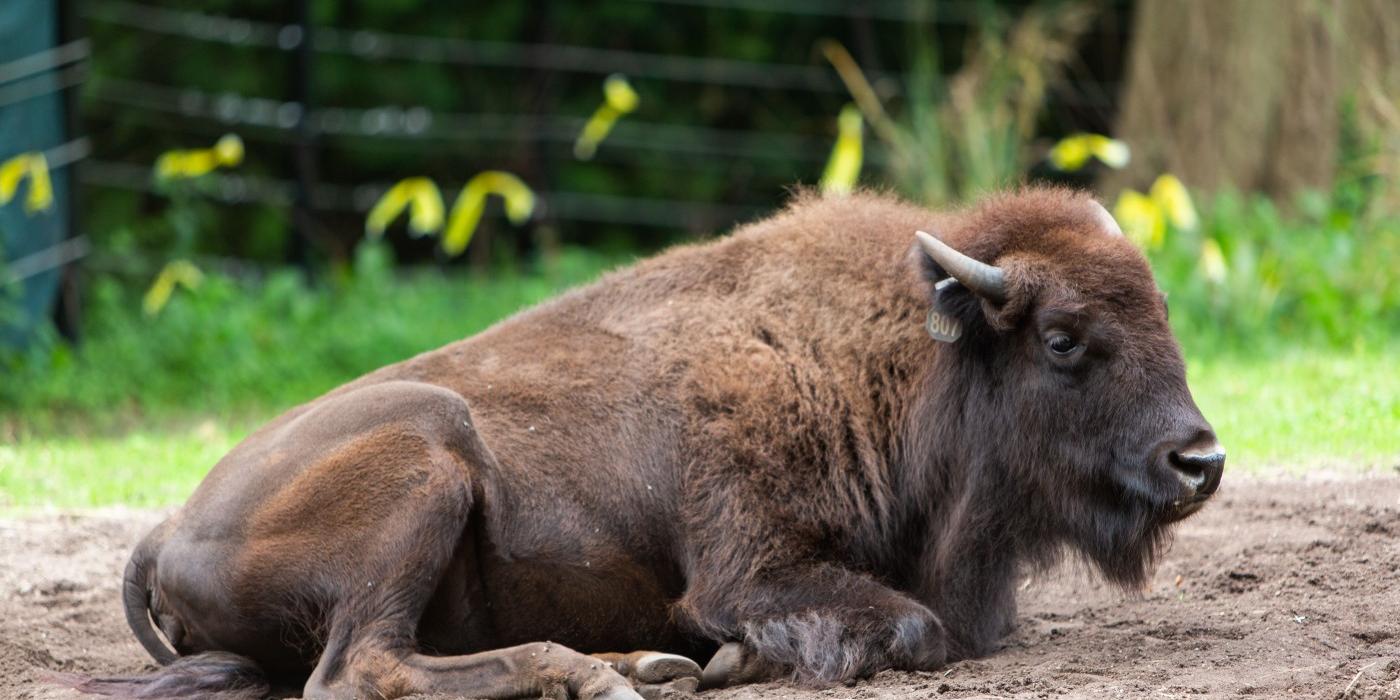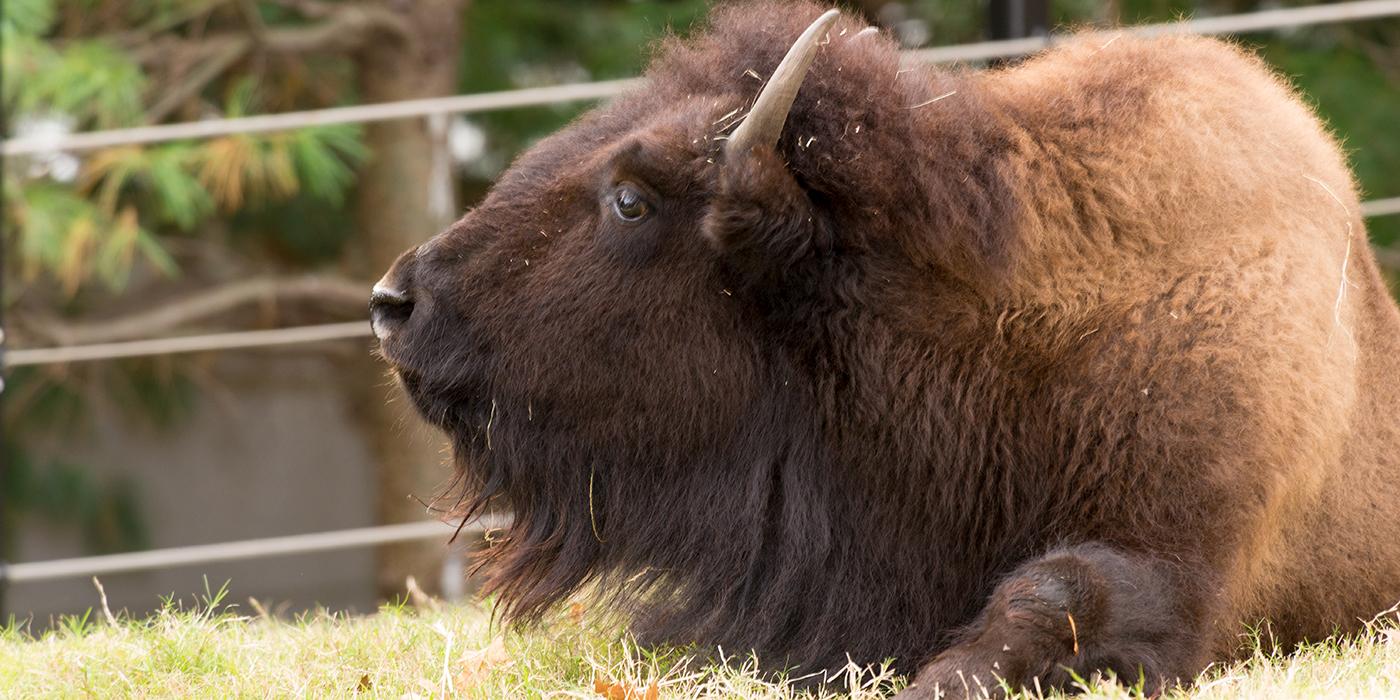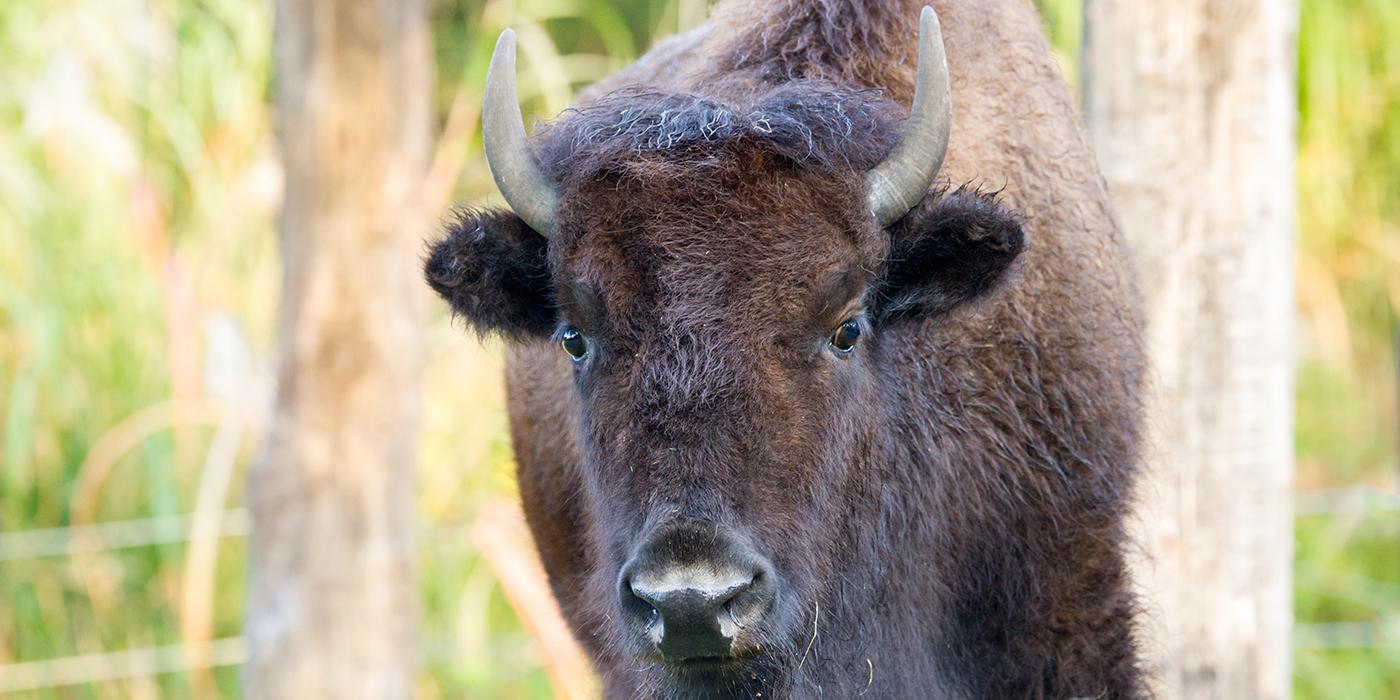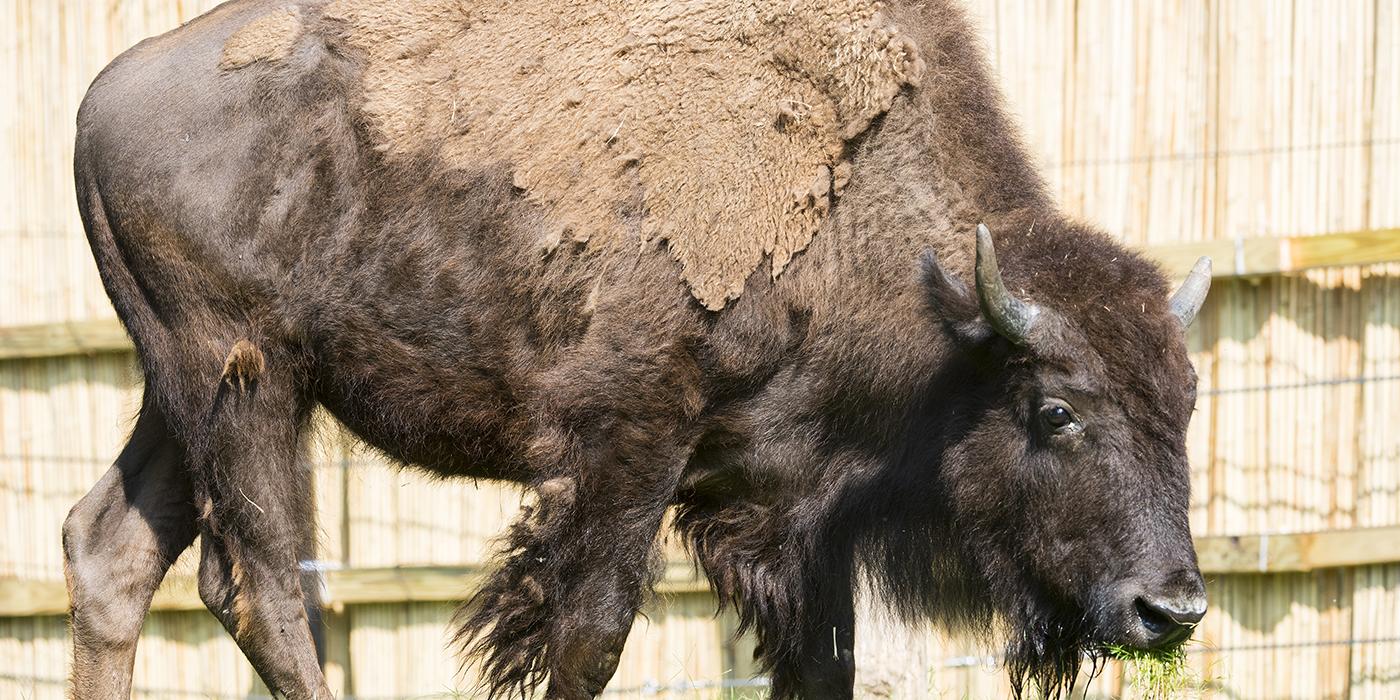Physical Description
The largest terrestrial animals in North America, bison are characterized by a hump over the front shoulders and slimmer hindquarters. Both male and female bison have a single set of short, sharply pointed, hollow horns that curve outward and up from the sides of the massive head. The head, neck, forelegs, and front parts of the body have a thick coat of long, dark hair. The adult bull adds to this thick coat with a black beard about one foot long. The rear part of the body is covered with much shorter hair. The shaggy head is the most heavily insulated part of their body, which has adapted as such to withstand blizzards as the animal stands facing into the wind. Heavy coats are shed in the spring as the animals roll to loosen the hair, which falls off in gobs.
Size
A mature bull can reach 5.5 to 6.5 feet (1.9 meters) high at the hump and nine to 12.5 feet (2.7 to 3.8 meters) in length. Females are normally smaller, at 7 to 10 feet in length (2.2 to 3.2 meters) and 5 feet high at the hump (1.5 meters). Bison can weigh 1,800 to 2,400 pounds (816 to 1,088 kilograms).
Native Habitat
At one time, bison were widespread from Alaska to northern Mexico, but the current range occupied by conservation herds has diminished to one percent of its original status.
Today, herds can be found in parts of Alberta, British Columbia, Manitoba, Northwest Territories, Ontario and Saskatchewan in Canada, as well as Arizona, California, Idaho, Montana, South Dakota, Utah, Alaska and possibly Texas in the United States. Modern conservation herds are substantially fragmented.
Originally, bison were found primarily in the grasslands and prairie of North America. Today, bison distribution is greatly limited due to population decline and their movements are greatly regulated. Within the national parks, bison are found at all elevations.
Lifespan
The life expectancy of American bison is 15 to 20 years. Adult bison are relatively safe from natural predators; however, weak, old or young bison may fall prey to mountain lions, bears or wolves.
Communication
Bison communicate through grunts to maintain contact with each other, and will snort to warn intruders. Male bison display their fitness by charging and butting heads with other bulls. They also bellow hoarsely, lower their heads, and paw the earth defiantly, but they rarely fight to the death.
They have an excellent sense of hearing and smell, but cannot see very well, so an entire herd can stampede if it is startled. Bison have cloven hoofs, and can reach speeds of 30 miles per hour.
Food/Eating Habits
Bison are year round grazers. They feed primarily on grasses, but will also consume flowering plants, lichens and woody plant leaves depending upon availability. To find grass in winter they sweep their heads from side to side to clear the snow. On the average, bison ingest 1.6 percent of their body mass per day of dry vegetation. Bison require water every day as well.
At the Smithsonian's National Zoo, bison consume a diet of orchard grass hay and herbivore pellets.
Sleep Habits
They prefer to graze in the morning, rest, ruminate (chew cud) in the middle of the day and then graze again in the evening. Bison wallow in the dust and mud to keep cool and to sooth irritating insect bites.
Social Structure
Bison are usually found in bands arranged by sex, age, season, and habitat. Older bulls are often solitary. Both cows and bulls live in a dominance hierarchy, which is established early in life. Most of the year, females with young form small bands, and immature bulls may stay with them. The bands may congregate in large herds in the spring or fall to search for food or water. Mature males have their own groups that may reach up to 30 individuals. Grazing takes place during several periods each day and is conducted in loose groups. When bison travel, they form a line. Bison are also adept swimmers, able to cross streams and rivers without difficulty.
Reproduction and Development
Females are sexually mature at 2 to 3 years of age. While males reach maturity around age three, they generally do not breed until six years of age. Mating season runs from late June through September, and gestation can last around 285 days. Breeding bulls will protect their chosen females and, with little time to eat, may lose more than 200 pounds during the breeding season. A single yellow-red calf will be born away from the herd in a secluded area. After a few days, the calf can keep up with the herd and follows its mother until the following spring. Calves are nursed for seven to eight months and are fully weaned by the end of the first year.
Conservation Efforts
Before 1800, bison roamed the Great Plains in vast numbers; estimates range from 30 to 100 million. While most were west of the Mississippi ranging to the Rocky Mountains, some were found east of the river in forested areas. Bison were once a major source of meat and hides in the United States; they formed the basis of the economy for a number of Native American tribes. However, by the 1890s, there were fewer than 1,000 of these animals left on the continent. The U.S. government slaughtered many bison in an organized effort to destroy the livelihood of Plains Indians.
Conservation threats to American bison include habitat loss, hybridization in managed populations and low genetic diversity among individual herds.
While bison have made a comeback since their population was devastated over 100 years ago, the species is still heavily dependent on conservation action for survival. Of the remaining American bison population, approximately 500,000 individuals are managed as livestock by private commercial ventures, while conservation herds are comprised of around 30,000 individuals. According to IUCN Red List guidelines, commercial herds are not eligible for inclusion in the IUCN's scope of wildlife conservation, so the IUCN status of bison reflects only those found in the 65 known free-ranging or partially-free-ranging herds.
Buffalo are Old World animals (Cape buffalo, water buffalo) and bison are only found in Europe and the United States. The taxonomy of bison has been under debate, and through DNA analysis it was determined that the two American subspecies—plains bison (Bos bison bison) and wood bison (Bos bison athabascae) are the same species. Many biologists have seen evidence that supports including the European bison, Bos bonasus, as the same species as the American bison. If proven true, this would have major conservation implications.
Help this Species
- Support organizations like the Smithsonian’s National Zoo and Conservation Biology Institute that research better ways to protect and care for this animal and other endangered species. Consider donating your time, money or goods.
- Are you a hunter? You can be an incredible ally for conservation! Check the conservation status of the animals you hunt and use methods that don’t impact other animals.
- Share the story of this animal with others. Simply raising awareness about this species can contribute to its overall protection.
Animal News

Leaf-tailed Gecko Treated for Skin Cancer With Chemotherapy








